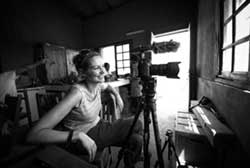Kristi Oloffson is creating a video record of another world, a world that might be a little hard for most Americans to accept. She’s just hoping that people will open their eyes and really see the images she’s capturing.
The 29-year-old Herscher High School grad is serving these days on a Mercy Ship, offering free medical services for the poor while docked in Madagascar in Africa. They arrived in August and will stay until next June. This mission was definitely a change of course for a career that seemed on the fast track — in a very different direction.
The daughter of Ron and Kathy Oloffson, Kristi’s a graduate of Indiana University where she majored in journalism and minored in music. She waitressed as a teen but quickly started building her career with well-chosen internships. After her sophomore year at IU, she worked as an editorial intern at an Indianapolis monthly. Her next stop was Money Magazine in New York City. She eventually landed a job at Time magazine.
“In 2010, I moved to The Wall Street Journal, where I primarily worked as a home page editor and mobile editor. I also helped develop a new app called ‘What’s News,’ which was just released,” she explained.
The thinking that led to the Mercy Ship assignment began in 2012 when she realized video storytelling was not only something she enjoyed, but something that was in line with her inherent skills. She borrowed cameras and gear and started teaching herself how to shoot and edit.
“The more I worked on it, the more I realized how much filming people and putting it with great music had a much more powerful effect on the viewer than my writing ever could,” she explained in emails from the coast of the African continent. She realized that nonprofit videos could tell an accurate story without trying “to manipulate people into thinking what’s going on is more dramatic than it really is.”
So what’s life really like on a hospital ship?
“My job is to follow a number of patients before and after surgery, to interview them, to find out their story and who they are. We always make sure patients are OK with us capturing their story before we start interviewing them or filming them. But a lot of times, it can really bring life to a patient when they see someone wanting to photograph them and film them. These people go through not just physical suffering but are often shamed for how they look, are outcasts by their villages and sometimes even their own families.”
What were you first impressions of the people Mercy Ships help?
“The kinds of things Mercy Ships treat are things you just don’t see in developed countries. In the U.S., if a tumor starts growing, a doctor removes it immediately. Here, that’s not necessarily the case. A benign tumor can grow until the point that it suffocates someone to death, and that happens. So we see large facial tumors, burn wounds that were never treated, cleft lips and palates, club feet, bowed legs.”
And no one on this mission is being paid?
“Every person on the ship is a volunteer. I had to fundraise [to cover] my expenses. We actually pay money each month for the privilege of volunteering. The reality is, operating a hospital ship is an extremely expensive endeavor. This way the money raised by the organization can go more directly to health care.”
What are your days like?
“We are docked in one location for 10 months. There are about 400 volunteers on board full time, and then we also employ about 200 local day crew, who serve as our translators and work alongside us. There are both long and short-term volunteers. Some people come for a few weeks, some stay for years. People are always coming and going.
“In general I work a standard eight- or nine-hour day, but I am often working after hours to edit projects just because I am always wanting to create more.”
What about little things like food and entertainment?
“We are fortunate: [The cost of living in Madagascar] is quite low, so we are able to eat at local restaurants for a few dollars. What’s difficult is some of the nicest restaurants in town are still out of reach for most of the Malagasy people, even though most Americans would consider the food quite inexpensive.
“The ship is a really fun place to be. We play games, go to karaoke, have dance parties, and drink a lot of coffee. It’s a community of like-minded people, and we work hard but also just spend time laughing and being together as friends, just like in any community. On the weekends we like to explore Madagascar. It’s a place of contrasts: it’s a paradise with beautiful scenery and beaches, but the poverty is not to be overlooked.”
Do you have time to be a little homesick?
“I miss my community in New York. I have a very close church community there that means the world to me. Like any expat, I miss some of the ease of life at home, but I’m really grateful to have this experience and to grow as a person through it.”
How will this impact your long-term career?
“I just want to keep telling the stories of humanity. The lack of health care in these nations is unbelievable. I can’t stand on the sidelines anymore and report about just anything. I want to use film to show the human side of global issues, especially the lack of health care. I would like to either keep doing video storytelling for nonprofits after this or go back to New York and work at a newspaper and do something similar.
“A friend of mine here recently told me that ‘humanity demands our attention’ and I think my purpose is to make sure this piece of humanity has their stories told — with dignity, respect, and truthfully, without sensationalism.”

